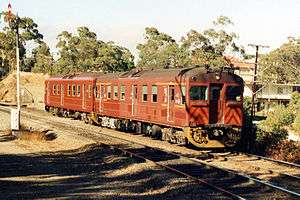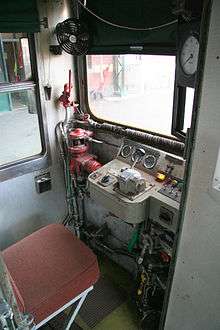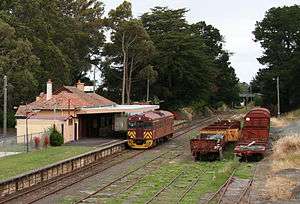South Australian Railways Redhen railcar
The Redhen railcars were a self-propelled railcar built by the South Australian Railways’ Islington Railway Workshops between 1955 and 1971.
| South Australian Railways Redhen railcar | |
|---|---|
 Two 400 class Redhens working a Belair line service in 1990 | |
_interior.jpg) Interior of a Redhen railcar | |
| Manufacturer | South Australian Railways |
| Built at | Islington Railway Workshops |
| Replaced | Brill railcars |
| Entered service | 1955-1996 |
| Number built | 111 |
| Number preserved | 34 |
| Formation | 2/3 carriages |
| Fleet numbers | 300-373, 400-436 |
| Capacity | 300-341: 91 362-373: 89 400-419: 80 420-436: 78 |
| Operator(s) | South Australian Railways State Transport Authority TransAdelaide |
| Specifications | |
| Car length | 20.00 m (65 ft 7 in) |
| Width | 3.05 m (10 ft 0 in) |
| Height | 4.27 m (14 ft 0 in) |
| Wheel diameter | 914 millimetres (36 in) |
| Maximum speed | 88 km/h (55 mph) |
| Prime mover(s) | 2 x GM model 6/71: 300-341, 362-373, 400-436 2 x Rolls Royce C6SFLH: 342-361 |
| Braking system(s) | Westinghouse air brakes |
| Track gauge | 1,600 mm (5 ft 3 in) |
History
The Redhen railcars were the backbone of Adelaide's metropolitan rail system between the late 1950s and the early 1990s.[1][2][3]
The first Redhens were introduced by the South Australian Railways in October 1955 to replace ageing suburban steam locomotive hauled trains in Adelaide.[4][5] Construction of Redhen vehicles continued until 1971, when the latest examples were built to supersede 1920s-era diesel railcars.[6]
TransAdelaide withdrew the last Redhens from regular service in December 1996, following delivery of a new fleet of 3000 class railcars. A number of Redhens have been preserved and are now operated by heritage and tourist railways.
Fleet details
The Redhens comprised two designs:[1][6]
- 300 class had a driving cab at one end of each railcar. These needed to run in two-car formations.
- 400 class had driving cabs at both ends, and could be used as a single car when needed, or in multiple with other railcars to make up longer trains.
In addition, there were a number of unpowered trailer cars, the 820 and 860 classes. These had been modified from steam-era suburban carriages and were used with the Redhens between 1955 and 1987.[2][6]
Construction
The Redhens were built in three batches. The overall design of the railcars was very similar, but there were differences in detail between the batches. Several railcars in the 300 class were re-numbered later in life, taking on the numbers of written-off or modified units.
The exterior of the units was always painted red, with variations in the colour of roofs and bogies over the years. The interior design and layout remained largely unchanged throughout their life. Some 300 class units were modified to provide guard's accommodation or space for bikes when the 860 class trailers were withdrawn in 1987. This slightly reduced the seating capacity of these modified cars.
| 300 class | |||
|---|---|---|---|
| Unit numbers | Dates introduced | Weight (tonnes) | Seating capacity |
| 300–341 | 1955–58 | 40.7 | 91 |
| 342–361 | 1959–61 | 42.7 | 91 |
| 362–373 | 1968–70 | 41.9 | 84 |
| 400 class | |||
|---|---|---|---|
| Unit numbers | Dates introduced | Weight (tonnes) | Seating capacity |
| 400–419 | 1959–61 | 42.5 | 80 |
| 420–436 | 1968–71 | 42.5 | 78 |
History
Deployment

When first introduced, all the 300 class Redhens were formed as 3-car consists, comprising an 820 or 860 class trailer sandwiched between two powered 300 class railcars. In peak hours, two sets were coupled together to form 6-car trains. On rare occasions, at times of heavy traffic demand, trains of Redhens could be up to nine cars long.[1][7]
Instead of building trailer cars to work with the 300 class cars, the South Australian Railways chose to convert existing rolling stock. To operate with 300 to 347, five 800 class and nineteen 850 class carriages were converted, becoming the 860 class. These steel cars had been built at Islington Railway Workshops between 1944 and 1946 as part of a plan to electrify Adelaide's suburban railways.[2]
For use with 348 to 373, thirteen wooden end loading suburban baggage cars were converted, becoming the 820 class trailers. These had been built between 1912 and 1924.[2]
The 400 class were used as single cars on the main lines during the evenings and at most other times on lightly patronised services such as the Grange, Tonsley and Northfield lines. They were also used in multiple with other 300 or 400 class units.
Super Chooks
Following the introduction of the 2000 class railcars in 1980, two 300 class Redhens and an 860 class trailer were chosen for an experimental rebuild at STA's Regency Park workshops. Nos 300, 337 and 862 were modified in 1983 with new interiors, elevated cabs and stainless steel panelling similar to the 2000 class. The rebuilt cars were re-numbered 2301, 2302 and 2501 and nicknamed Super Chooks (a chook is a chicken in Australian vernacular) entering service in June 1983.[2][8][9] The exercise was not successful and no more were modified. The Super Chooks saw only limited passenger service and often 2301-2302 was sandwiched in between two 400 class Redhens before they were withdrawn in 1992.[10]
Withdrawal
| Preserved Redhens (January 2020) | ||
|---|---|---|
| Unit Numbers | Location | |
| 321 400 | National Railway Museum, Port Adelaide | |
| 334 364 405 412 424 428 824 435 875 |
SteamRanger, Mount Barker 875 gifted to SteamRanger from the National Rail Museum, moved in February 2019 [11] | |
| 2301 2302 2501 |
Coolac, New South Wales | |
| 432 | Hunter Valley, New South Wales | |
| 406 | Big Orange tourist park, Berri[12] | |
| 311 402 | South Gippsland Railway | |
| 436 | Stored in various locations in South Australia Victoria & New South Wales 436 had its interior burnt out. As a result, usable parts were taken off and the railcar was scrapped. Parts like the number board and horn still exist in the Wallaroo Museum in the old post office. | |
| 372 317 339 |
privately displayed in Riverton Railway Station. There is also another Redhen Railcar here but its number is unknown. | |
| 373 416 |
For sale at Australian Train & Railway Services[13] | |
All thirteen of the 820 class trailers were retired by December 1976. The corresponding 300 class Redhens were then coupled to a 400 class railcar to form 2-car trains (designated 300/400 class).[2] In 1987, the steel-bodied 860 class trailers were withdrawn and all the 300 class Redhens were reconfigured as 2-car trains, usually consecutively numbered pairs.
In 1987/88 the State Transport Authority introduced the first of its new fleet of 3000 class railcars, which were intended to replace the Redhens. As more 3000 class were delivered through the early 1990s, the Redhens began to be withdrawn and were gradually restricted to operating only during weekday peak hours. This was especially the case when driver only operation (DOO) was introduced in the early 1990s. The manual sliding doors made Redhens unsuitable for DOO and guards had to be retained to supervise passenger boarding and alighting.
By January 1996, only 16 remained in service, confined to peak-hour Gawler, Outer Harbor and Tonsley services.[14] The last remaining railcars which were 400 and 321 did a farewell tour around the Adelaide network, then they travelled to their new home, the National Railway Museum. after this, they were withdrawn on 15 December 1996.[15][16]
Preservation

Whilst in service the Redhens were mechanically robust and reasonably reliable; they were attractive options for use on heritage and tourist railways after retirement. However, their age, and the increasing service time since overhaul, has affected their reliability in preservation. Some continue to operate on broad gauge lines in south-eastern Australia. Many have been broken up, but the first and last units and a few others still exist.[17][18][19][20]
The National Railway Museum have 321 and 400 in preservation.[21][22]
The South Gippsland Tourist Railway (SGR) purchased Redhens 311, 402 and 416 in 1993
Redhens 303 and 308 are privately owned and have been converted into accommodation on land adjacent to the northwest boundary of the Blackwood railway station.
Model
SAR Model Co make's a HO model kit, Both the 300 and 400 cars are produced with both unpowered and powered kit versions. The powered kits are supplied with a SPUD power units. Available kits are: 300 class 2 car kit, 400 class single car kit, 300 and 400 class box set (1 of each type) they are sold in a wooden box.
References
- "The 300-400 Class Railcars and 829-860 Class Trailer of the South Australian Railways" Australian Railway Historical Society Bulletin issue 576 October 1985 pages 219-242
- "The 300-400 Class Railcars and 829-860 Class Trailer of the South Australian Railways" Australian Railway Historical Society Bulletin issue 577 November 1985 pages 243-261
- "The 300-400 Class Railcars and 829-860 Class Trailer of the South Australian Railways" Australian Railway Historical Society Bulletin issue 578 December 1985 pages 279-283
- "Multiple-Unit Diesel Trains" Railway Gazette 30 July 1954 page 120
- "Australasia" Diesel Railway Traction April 1956 page 134
- McNicol, Steve (1981). STA Railcars. Elzabeth: Railmac Publications. ISBN 0 949817 01 5.
- "STA Happenings" Catch Point issue 69 January 1989 page 24
- "Metropolitan Area - Broad Gauge Lines" Catch Point issue 36 July 1983 page 17
- "Here & There" Australian Railway Historical Society Bulletin issue 552 October 1983 page 114
- "STA Railcars to be Saved" Catch Point issue 102 July 1994 page 11
- "860 Class Steel Railcar Trailer Cars". www.comrails.com. Retrieved 3 January 2020.
- "Yorke Peninsula Rail Disposals" Catch Point issue 195 January 2010 page 42
- 342 Australian Train & Railway Services
- "Red Hen's Indian Summer" Railway Digest March 1996 page 17
- "Farewell Red Hens" Railway Digest February 1997 page 16
- "TransAdelaide Redhe Disposal - The Final Chapter" Catch Point issue 119 May 1997 page 14
- Redhen Railcars 300 to 373 Chris' Commonwealth Railways Pages
- Redhen Railcars 400 to 436 Chris' Commonwealth Railways Pages
- SAR 820 Class Wooden Railcar Trailers Chris' Commonwealth Railways Pages
- 860 Class Steel Railcar Trailer Cars Chris' Commonwealth Railways Pages
- "Where Did All the Red Hens Go?" Catch Point issue 168 July 2005 page 16
- Red Hens return for a special weekend ABC News 29 November 2013
External links
![]()